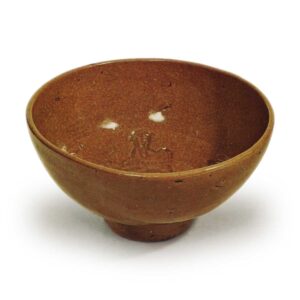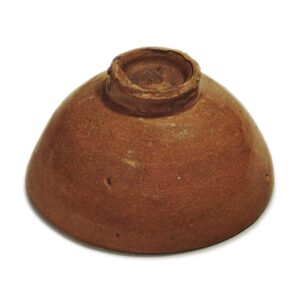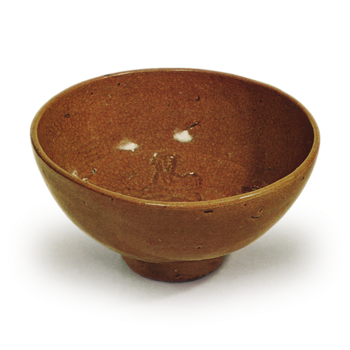

Height: 6.2-6.4cm
Diameter: 12.5-12.8cm
Outer diameter of foot ring: 4.7cm
Height of foot ring: 1.2cm
This tea bowl is famous as a tea bowl made by the doll maker of the Juichiya family, a wealthy merchant family in Nagoya.
The clay is a strong red clay with a high iron content, and the firing is hard. Judging from the clay, it is probably from Zhejiang or Fujian. It appears to have been made on a fast potter’s wheel, and the shape and the inside of the foot ring have a flowing, helmet-like appearance. The glaze that covers the entire surface is a yellowish orange color, and because it contains a high proportion of glass, it is very shiny, and the glaze surface is covered with fine double craquelure. The white spots that can be seen here and there are probably due to the straw ash that was mixed in.
When you read it like this, it seems like a special glaze, but it is actually a celadon glaze made mainly from clay ash, and it just happened to turn this color because it was fired in an oxidizing flame, depending on the kiln or how it was fired. If it had been fired in a reducing flame, it would have turned a beautiful blue-green color, just like the celadon from Longquan kilns.
In China, this type of ware is called “rice-colored celadon”, but Japanese tea masters called it “hishio-te” (hishio is the name of a type of soy sauce, and the word “te” means red, and so this name refers to the reddish color of the ware). . This was because, in contrast to the vivid but reserved colors of celadon wares such as “Maboshi-ban” and “Mangetsu”, this one was warm and soft, and suited the wabi-cha aesthetic.
The exterior of the tea bowl is plain, but the interior is decorated with carved patterns. In other words, a horizontal line is drawn halfway up the inside wall, and above this, a band of thunder-shaped patterns is wrapped around the rim, each pattern being a long rectangle. This is, of course, a molded pattern. And on the lower rim, two pairs of Chinese children and Chinese flowers are stamped in opposition. The ancient people called these tea bowls with dolls on them “Ningyo-te” because of these Chinese children. The two Chinese children and the broken branch each have slightly different shapes, but it would be strange to use different marks, so perhaps the marks changed depending on the pressure applied. The inside bottom, surrounded by these four marks, is a hollow about 3 cm in diameter, or a tea pool, which adds even more flowers to the scenery of this tea bowl.
As you can see in the photo, the surface of the tea bowl is covered with small holes and scratches of various sizes, and the foot ring is even slightly stuck together, so it cannot be said to be a high-quality piece, but its simple, attractive shape, together with the color of the glaze, must have been loved by the wabi tea masters of old. This kind of taste would eventually lead to the production of well bowls with a loamy skin and a loquat-colored glaze.
It was originally owned by Juichiya and Ko-Oke, but in 1932 it was passed to the ownership of Sanrakuan in Ohara, and then to the current owner. It is said to be the best tea bowl for making dolls.



